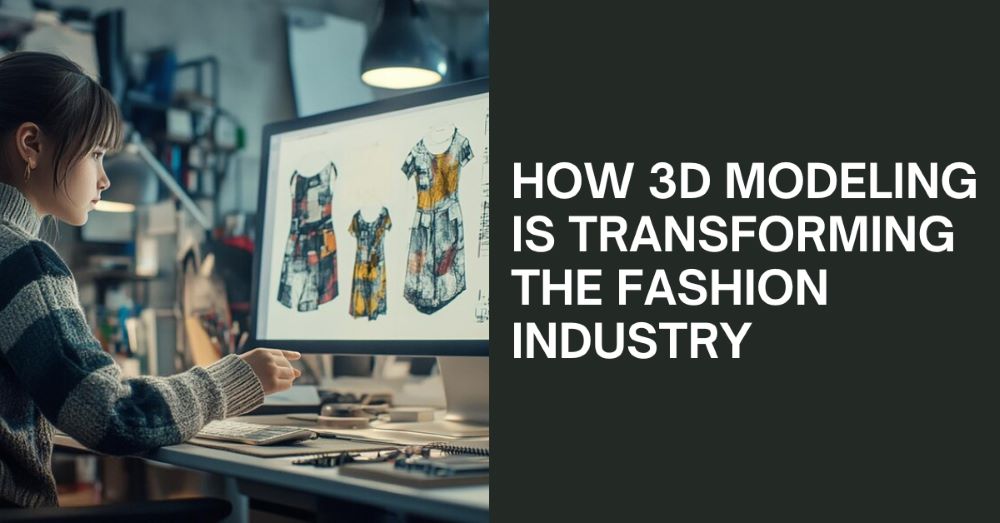The fashion industry is witnessing a digital revolution led by 3D product modeling. Technologies that once seemed futuristic—like Shudu Gram, a hyper-realistic digital model, or 3D-printed garments—are now driving real-world transformations. By blending artistry with technology, 3D modeling is redefining fashion design, production, and marketing. This blog delves into the profound impact of 3D modeling on the industry and how you can implement this technology successfully to streamline workflow and boost profitability.
Table of Contents
How 3D Modeling Impacting Fashion Industry – Use Cases
3D modeling is used for various aspects of the fashion sector. Let’s see its key applications, its importance, and reason for rising adoption:
- Virtual Try-Ons for Enhanced Customer Experience
3D fashion models are primarily used for creating virtual-try-on solutions to help shoppers visualize how garments or accessories will look and fit without physically trying them on. By leveraging AR and 3D-rendered models, brands can offer an immersive shopping experience where users can mix and match outfits, experiment with sizes, and customize designs. This helps in avoiding last-minute disappointments and reduces product return rates to a great extent. For instance, some Shopify sellers have reported a 40% reduction in product return rate after implementing 3D product modeling.
- Virtual Prototyping and Sample Development
3D modeling also helps fashion brands to create virtual prototypes or digital samples of products before their manufacturing to save time, resources, and, most importantly the sample-making cost. These prototypes can be shared with clients, suppliers, and partners to get their feedback and make the required changes. Also, the designers can leverage these 3D fashion designs to evaluate multiple variations of a single product digitally, saving weeks typically spent on manufacturing a physical sample.
- Virtual Fashion Shows
The rise of digital models and 3D catwalks is transforming how fashion shows are conducted. 3D modeling allows brands to create entire virtual runway experiences, complete with lifelike models wearing intricate designs. These virtual shows are not only cost-effective, environmentally friendly, and accessible to a global audience but also allow brands to experiment with surreal environments, unique animations, and futuristic themes that are impossible to achieve in physical settings.
- Real-Time Fit Simulation
Real-time fit simulation powered by 3D modeling replicates how fabrics move and fit on different body types under various conditions. Advanced 3D tools like CLO and Browzwear simulate fabric properties such as elasticity, weight, and texture, providing designers with a clear understanding of how their garments will perform. This technology is particularly valuable for tailoring custom pieces or ensuring consistent quality across mass production. Brands save time and resources by identifying design flaws early in the process, reducing the need for costly physical revisions.
- Interactive Marketing Campaigns
3D models are also used by marketing departments to create dynamic content, such as customizable virtual outfits or AR filters that allow users to “wear” their designs on social media to increase online engagement.
For example, Gucci partnered with Snapchat to launch their first AR-powered virtual shoe try-on campaign. By leveraging Snapchat’s AR platform and SnapML feature in the Lens Studio, the brand facilitated a virtual try of their latest sneaker collection to redirect interested shoppers directly to their official website. This campaign became extremely popular and helped Gucci drive more traffic and conversions on their website.
Benefits of Using 3D Modeling for the Fashion Industry
- Makes Collaboration Simpler
3D product models serve as a unified visual reference, enabling effective collaboration across different teams within a fashion brand. Designers can use them for experimenting with ideas, visualising intricate details, and communicating their concepts clearly to production teams. Marketers and sales teams benefit from photorealistic 3D models for creating impactful promotional materials, catalogs, and virtual try-ons, ensuring alignment with the brand’s vision.
Additionally, product development and quality assurance teams can review these models for precision, fit, and design consistency before physical prototyping, reducing errors and revisions.
- Reduces Sample Making and Supply Chain Cost
3D apparel models significantly reduce the reliance on physical samples, cutting down expenses related to production materials and logistics. Instead of creating and shipping multiple prototypes to retailers, brands can showcase designs virtually, saving time and resources. A prime example is Tommy Hilfiger, which adopted 3D fashion design to streamline its processes, achieving up to an 80% reduction in sample-making costs. [Source]
Moreover, 3D models allow for precise design adjustments early in the process, reducing the likelihood of errors during manufacturing. They also support on-demand manufacturing by enabling virtual fittings and customer previews, minimizing overproduction and inventory storage costs.
- Faster Time-to-Market
By creating 3D models of garments, companies can reduce the entire design-to-market lifecycle (from creating a physical sample to launching it in the market to get feedback and make the required changes). 3D product models enable fashion brands to pre-sale and virtual showcase their designs before physical production begins.
Also, the 3D models can be used in marketing campaigns, eCommerce listings, or virtual showrooms to gauge customer interest and secure orders in advance. This not only accelerates the feedback loop but also minimizes production risks by ensuring demand before manufacturing.
- Promotes Sustainability
3D fashion models decrease fabric waste, water consumption, and carbon emissions from sample production and international shipping, promoting sustainability.
- Facilitates Immersive and Interactive Shopping Experiences
3D fashion models allow customers to virtually examine intricate details, explore items from every angle, and even interact with features like color or material variations in real-time. This level of engagement mimics in-store experiences, allowing shoppers to make informed decisions without physical interaction.
What Makes 3D Modeling Implementation Challenging in the Fashion Industry?
- High Initial Investment
One of the most significant barriers to adopting 3D modeling in the fashion industry is the steep upfront cost. 3D product modeling tools don’t come cheap and demand a significant investment in terms of subscription fees.
Additionally, businesses have to invest in training employees to adapt the technology to their processes, further increasing expenses. As a result, small startups and budget-constrained companies may find it difficult to afford these tools, delaying adoption in cost-sensitive segments.
- Steep Learning Curve
Fashion designers or professionals accustomed to traditional methods often find it challenging to transition to digital tools. They need specialized training to be proficient in using 3D product modeling tools (such as Maya, Blender, AutoCAD, and 3ds Max). This steep learning curve can slow down implementation and productivity.
- Limited Compatibility with Legacy Systems
Integrating advanced 3D modeling tools with legacy systems can be challenging due to compatibility issues. These tools demand high computational power, which is difficult to achieve with outdated systems. Incompatibility between 3D modeling software and legacy systems can lead to inefficiencies and additional costs for upgrades.
- Data Management and File Sizes
Due to their significantly large file sizes, 3D models, especially highly detailed ones, require robust storage solutions and streamlined data management workflows. If a data governance framework is not in place, managing these files across departments or stakeholders becomes a logistical and technical hurdle.
- Time-Intensive Process
Fashion 3D modeling is time-intensive as you must replicate fabric physics, as well as intricate details like stitching, pleats, draping, and material texture. Creating realistic animations for movement and fit adds another layer of complexity, especially when making multiple product variations.
For fashion businesses operating on seasonal deadlines, this extended modeling process significantly impacts collection launches and market delivery timelines, especially when scaling operations to meet client demands.
How Can Outsourcing 3D Modeling Services Be a Viable Option for Brands?
The above-stated challenges are prevalent when you build an in-house team. By outsourcing 3D modeling services for the fashion industry, you can overcome these challenges and achieve key benefits like:
- Cost Efficiency
By outsourcing fashion 3D modeling services to professionals, you can eliminate the need for high upfront investments in licenses, infrastructure, and employee training. Professional service providers already have access to the latest tools and thus can work on your preferred software for creating high-end 3D models.
Additionally, outsourcing companies have flexible engagement models (which allow businesses to pay only for the services they need) to avoid long-term overhead costs.
- Access to Expertise
3D product modeling companies have a vast pool of dedicated and experienced resources who are proficient in using advanced tools and techniques to work on complex project needs. They offer seamless execution with minimal learning curve challenges.
- Seamless Scalability
By outsourcing 3D fashion modeling services, brands can avoid the complexities of managing an internal team. They can easily scale up or down based on project requirements without long-term commitments to in-house resources.
- Faster Time-to-Market
Professional service providers have specialized teams to handle time-intensive 3D product processes efficiently, accelerating production cycles. They also scale operations quickly to meet seasonal demands, ensuring timely product launches without compromising quality.
- Streamlined Integration
3D product modeling service providers often have the infrastructure to handle compatibility issues with legacy systems, ensuring smooth integration without additional upgrades.
- Efficient Data Management
Experienced outsourcing partners implement robust data governance practices, offering secure and organized management of large 3D files and ensuring easy collaboration across stakeholders.
Key Takeaway
Indeed, 3D product modeling is making impactful transformations in the fashion industry, promoting sustainability, profitability, and faster time-to-market. From hosting virtual try-ons to creating interactive marketing agencies, 3D fashion designs are allowing brands to provide richer and more engaging experiences to shoppers to drive better conversions. If you are not leveraging this technology yet, this is the right time to act. Leverage professional 3D modeling services to enhance your brand’s creative capabilities and stay ahead of the curve.
Author Bio –
Lara McDaniel is an accomplished blogger with 8+ years of experience. Her love for reading on a wide range of subjects fuels her insightful writing on a variety of topics, from cutting-edge tech developments and eCommerce trends to creative niches like fashion photography and ecommerce product photo editing. She also attends webinars and follows industry leaders to enrich her knowledge about what’s happening in different sectors.
Plagiarism and AI-detection report



